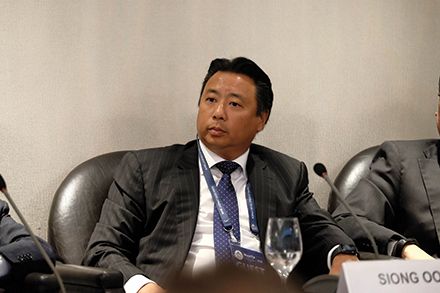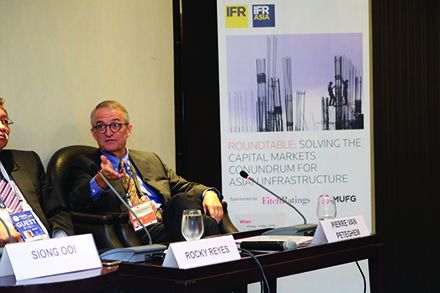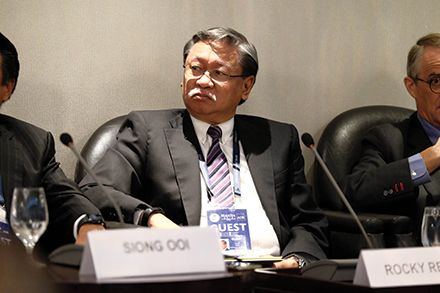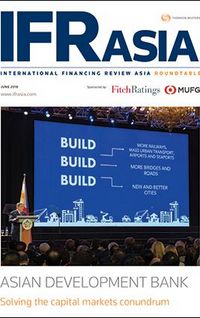IFR ASIA: Pierre, I know this is something that you’ve been personally involved in as an issuer. Is there more money looking for green investments in Asia?
PIERRE VAN PETEGHEM, ADB: Yes, Steve. I’m probably going to say something that most of you in the room already know but I think it’s important in order to set the background. The ADB has a strategic objective to allocate 30% of its operations to projects addressing the issue of climate change. Since we are planning to get to US$20bn of lending operations by 2020, that means about US$6bn by then. Two-thirds would be for climate change mitigation and one-third for climate change adaptation.
What have we done? Well, in 2017 we were already well on our way there. We had US$4.6bn of climate change operations, of which US$3.2bn was for mitigation. That means that the treasury department of this institution has a lot of Green projects that can be refinanced by Green bonds, and we have been quite active in issuing Green bonds. We have sold more than US$3bn since 2015 in three currencies. Mostly it is in US dollars, but I’d like to say that we also issued a local currency Green bond in Indian rupees.
The Japanese investor base has always been at the forefront of climate change issues, and we had already issued, from 2010 actually, in excess of US$2.4bn of related clean bonds, for clean energy and also water projects.
We think that there is a very, very strong future for the Green bond market. At the current stage, probably demand is greater than supply. Of course, it’s good for an issuer to be in that position!
KIYOSHI NISHIMURA, CGIF: The Philippine peso project bond we supported for Aboitiz was the first Green bond in Asia to be certified by the Climate Bond Initiative.
That experience actually taught us about some challenges we will face when we try to develop Green finance in the ASEAN bond market. Initially, Aboitiz was not really keen to make it a Green bond, or a climate bond, and that’s generally the problem with the Green bond market in Asia. The Green bond market has grown from the bottom up, in a sense, in more developed bond markets, where there are dedicated Green investors. The issuer has an incentive to issue Green bonds to tap that investor base – irrespective of whether that’s going to give them some price advantage or not. But in Asian and the ASEAN countries, you don’t see such dedicated Green investors in local bonds yet. That means there is no real incentive for issuers.
I think it can still be done. Look at China. China is one of the largest Green bond markets in the world, and it’s developed within just a few years simply because the government put policies in place. I think the Green bond market in ASEAN is also going to be driven, probably, top-down. We already see activities from ASEAN governments in that direction.
First of all, the ASEAN countries established their own set of Green bond standards last November, which is a good sign. Also, countries like Singapore and Hong Kong have introduced incentive schemes to develop the Green bond market. The Indonesian government has also introduced a Green sukuk framework, and in Malaysia several companies issued Green sukuk last year.
All these government initiatives will eventually lead to the emergence of dedicated investors for Green bonds, even in the ASEAN markets.
AUDIENCE: Kiyoshi san mentioned China’s Green growth, but at the same time, we also know that there is still a gap between Chinese and international standards. Are you implying that the ASEAN countries would also have to follow a similar path, for example accepting clean coal, before integrating them with the international standards?
Secondly, I want to ask about Panda bonds. I know that MUFG, along with Mizuho, became the first Japanese issuer to sell onshore bonds in China earlier this year. Do you think we’ll see more foreign issuers there to finance projects under the Belt & Road Initiative?
KIYOSHI NISHIMURA, CGIF: Thank you very much, that’s a good question. I use the China example to show the top-down approach. The government decided to create a Green bond market, and the market responded. But you are right that the PBOC guidelines, in certain areas, are different from the international standards, allowing coal-fired projects, large hydro projects and so on. There is a difference.
I understand that China and the EU are working together on this. Eventually, I think there will be one standard, because China also wants foreign investors in its own Green bond market. Interestingly, a number of offshore Green bonds issued by Chinese companies already follow the international standards.
But in the case of ASEAN, the Green bond standard introduced last November is based on the Green Bond Principles, which are a core part of the international standard. In ASEAN’s case it’s clear that they wanted to do something which met international standards from the beginning.
IFR ASIA: The second point was on the Panda market, I think? Siong, do you want to have a crack at that one?
SIONG OOI, MUFG: I’m not sure of the exact use of proceeds for that, but to the extent that we, MUFG, look at all different markets for funding, for diversity and efficiency, it makes sense. Onshore China is clearly a market that we’ll look at.
There is a lot of talk on the Green bonds here and if I could just add to that conversation? I think there’s a fundamental step here that we need to talk about, which is the development of the bond markets in general, before we get very specific about the Green bond market.
In terms of growing the asset class to meet investor demand, more broadly, it doesn’t have to be in Green format. Certainly we’re hearing there’s a very strong positive bias towards renewables projects. A lot of comments were around standardisation. If you look at the US markets they’re the biggest, deepest, most liquid markets in the world, so I think it’s interesting that there are lots of discussions around different markets having different standards. If you want to attract the biggest pools of liquidity, which sit in the US and in Europe, in certain respects, you have to follow that template.
So, I think it’s a more fundamental discussion here around how do we get more projects funded in the capital markets versus the bank markets? As a first step. I think that’s a pretty key question to answer.
AUDIENCE: I was wondering if the panel could comment on what’s going on right now with the Philippine bond market? There are some changes around the Philippine dealing system and reforms in the local bond market. How do you think that affects the investor perception of the Philippines at this point?
Also, could you comment on the level of interest of foreign investors in financing infrastructure here in the Philippines?
PIERRE VAN PETEGHEM, ADB: I can try to address this question, only partially. Currently there is a collaboration between ADB and the government of the Philippines in order to upgrade the state of the bond market in this country.
One example, we have advised the Debt Management Office of the Philippines to generate a set of benchmarks across the curve. Before there were a whole set of bonds that were issued one after the other which, of course, was not very conducive for liquidity. The Philippines is moving in that direction already in the offshore market.
We’re also discussing the derivative markets, which is often what’s lacking in almost all emerging capital markets. I’m talking about interest rate swaps, options, repos. All of those things are either non-existent or are only at a very early stage; the IRS can sometimes go to three months, six months, maybe one year, but not much longer than that. But, you need an interest rate benchmark, a variable benchmark, and we are working with the Philippines as well in order to come up with something in that regard.
IFR ASIA: Olivier mentioned earlier on that many infrastructure investors are very happy with Triple B risk. Now that the Philippines is investment-grade rated, and Indonesia too, are you seeing a lot more infrastructure financings come to that market out of this region?
OLIVIER DELFOUR, FITCH: Yes. My comment was targeted more at the European situation. Again, on the negative side, what would stop investors from looking closely at any given market are more specific risks. But keep in mind the reason we’re all discussing an infrastructure bond market is because there is a large pool of investors that are looking for long-term returns.
Liquidity is not necessarily a problem. For a number of big investors in the more developed markets, liquidity is actually an enemy, because it means lower pricing. If you are truly a long-term infrastructure investor then what you really want is the yield on these assets.
So, if you want to develop an active infrastructure bond market, you really need to get investors comfortable with engaging in these projects for the long term. They will want to have reasonable comfort that the rules of the game are not going to change in three years’ time. If, again, there is currency risk and there is no hedging instrument in place for the duration, that’s another hurdle. Refinancing risk is an issue that they will be concerned with. An infrastructure investor needs to believe that the assets are there for the long-term and will generate cashflow.
IFR ASIA: I remember looking at the Paiton deal in Indonesia, and a lot of people were surprised that it had an investment-grade rating. Can other projects there get up to that Triple B mark?
OLIVIER DELFOUR, FITCH: Actually, we rate a number of projects like that. Often the constraint to the rating is actually the sovereign rating and/or the off-taker’s rating in the case of power projects. Take a PPP, for example. A true PPP, where the government is paying the annual instalments, is only as good as the person paying the bills.
It’s not that difficult, with proper leverage and proper structuring, to make this product investment-grade. The constraint is really if the off-taker or the country is not investment-grade. Then it’s very difficult.
IFR ASIA: Pierre, you mentioned the ADB works hard to open up some of Asia’s local currency markets. What are the latest developments you can share with us there?
PIERRE VAN PETEGHEM, ADB: The latest development actually was only yesterday – perhaps because they knew you had organised this panel! We got authorisation from Mongolia to issue in their market, in the offshore and onshore market in their currency, the tugrik. The last time we issued in a local market where the country is also our shareholder was in Indonesia. We brought a sizeable issue back in December in the so-called Komodo market, which is the offshore market for the Indonesian rupiah, for an amount of about US$75m.
Typically, we repatriate those funds onshore and we park them in government bonds until we can use those proceeds to refinance our operations there. It’s kind of interesting because we have succeeded in some markets in decoupling the funding side of the equation from our lending. Before, it was a bit of a chicken-and-egg situation: our colleagues from the operation side did not believe that we had the capacity to provide local currencies, so they wouldn’t really pursue projects in local currency, or they would say to the borrowers that they could only provide US dollars.
So, this is where we are able provide more liquidity in local currency to be deployed in financing our infrastructure operations in those countries.
IFR ASIA: Does anyone else have a view on some of these more frontier markets opening up and the challenges around that?
SIONG OOI, MUFG: Just picking up on a point Olivier mentioned before. Some of the big markets, the Philippines, Indonesia, etc, because they’re now investment-grade, that strikes a sweet spot with US institutional investors, for example, in the US private placement market, which is more flexible than the public market. Some investors are just happy to take that risk outright.
I think there’s more scope to use credit enhancement to develop appetite in the more emerging markets – like Bangladesh, etc – to kick start things, both on the loan side as well as on the bond side. If we didn’t have credit enhancement, it’s maybe a little bit hard for investors to get their heads around some of the risk elements that Olivier talked about.
It’s horses for courses. We’re talking generically about Asia, but there’s a big difference between the investment-grade deals, where there’s huge amounts of liquidity, and then deals in frontier markets, which obviously need the funding for infrastructure as well. We need to figure out a way to kick-start that.
KIYOSHI NISHIMURA, CGIF: I have a strong view that infrastructure projects should really be financed in local currency, because their revenues are in local currency. We should really try to develop the capacity of the local financial system to bring in the long-term funding that is needed.
You’re talking about frontier markets. Our largest operation is actually in Vietnam, where CGIF-guaranteed bonds today account for more than 10% of the whole Vietnamese corporate bond market.
But, people sometimes don’t understand that what’s available in the local capital markets. Today the Vietnamese dong 10-year government bond yields about 4.7%, which is only 1%–2% more than the US Treasury. So, you can finance long-term investment at a quite reasonable rate.
Many people say local currency financing is too expensive. But it’s not true. Actually, it could actually be cheaper than borrowing in US dollars, and you don’t have to carry the exchange risk. That’s the way we should go forward.
IFR ASIA: There are ways to de-risk some of these in the private sector as well, I think we mentioned insurance companies before. Kiyoshi, I know you’ve looked at some of that?
KIYOSHI NISHIMURA, CGIF: Yes. Interestingly, we share 25% of all our risk with the global reinsurance market. When we started issuing guarantees five years ago, we contacted the insurance industry to find out if anybody was interested in taking a project or corporate risk in the local currency in an emerging Asian country. At that time, we couldn’t find any. But about two years ago we saw a lot of interest from the global insurance industry.
If you talk about how to use a global insurance company’s money to finance infrastructure investment in emerging countries, most of the time people are talking about the asset side of their business. Here, insurance companies are very conservative; they don’t want to invest in sub-investment grade bonds, and they don’t want to take any exchange risk. But when they provide insurance cover, which is the liability side of their business, they are more flexible because risk taking is their main business. We found that the currency was not a big issue to them because they only owe contingent liabilities which don’t need immediate funding in local currency; they are more interested in the probability of a loss, which they are good at controlling.
This is actually one way we can mobilise more risk-absorption capacity for infrastructure finance in emerging countries. If the global reinsurers can support domestic funds in long-term infrastructure investment by providing risk cover, I think this is going to be a big boost for the emerging markets, because there are already funds available in the domestic financial systems but risk-absorption capacity is still lacking there.
PIERRE VAN PETEGHEM, ADB: I would like to echo that. We, too, are not only on the offer side we’re also on the buy side. There are some infrastructure projects – say, for example, a large solar plant, a geothermal project, you name it – where the funding requirements may be anywhere between US$500m and US$1bn. This is something that Asian Development Bank will take the lead on, but for various reasons, like sectoral limits or single-borrower limits, we are not able to fund the entire package. Yes, we also have a syndication unit that works hard in terms of unloading some of the risk, but we also take recourse to the global insurance and reinsurance market.
Our private sector portfolio, which means it is not guaranteed by any government, is roughly US$6bn of outstanding loans. Of that, 20% is – to use our jargon – risk-transferred, which means 20% is reinsured in such a way that we have ceded the credit risk to insurance and reinsurance companies. So, we have been able, to some extent, to attract unfunded capital into the region to help fund infrastructure.
IFR ASIA: There are a lot of ideas there on just how we can expand capacity. Siong, we were talking a little bit before about the potential for Asian issuers to access some of more developed markets, the Japanese investor base, for instance. Is that an alternative route for Asian infrastructure?
SIONG OOI, MUFG: The short answer is yes, definitely. I don’t want to detract from the local currency markets; it’s important for those markets to develop. The point I’m trying to make is that it’s a step-by-step approach. I think we need a mindset shift to get sponsors comfortable with accessing the bond markets rather than traditional bank markets, and that template is much more established in the international markets. It’s a question of sequencing.
To answer your question on Japan, I don’t think I need to explain to everyone about the macro environment in Japan. Because of the negative interest rates, there is a lot of liquidity chasing assets, so we’ve sought to tap into that pool of liquidity. We’ve had some success in Australia, taking two desalination projects to Japan. One in Victoria, for around A$760m, was a 15-year deal sold to both Japanese regional banks and life insurance companies. That’s one of the first deals of its kind. We’ve also done a follow-up in Sydney, where the investor base was similar, plus we brought in a couple of new non-bank investors.
We’ve also led a number of US private placements in electricity distribution and transmission space in New South Wales. That market has really developed, as a consequence of investing in investor education. There’s now a pretty deep market for those kind of credits, and they can even now do Aussie dollars.
The easy way to do those deals would have been in the Aussie loan market, or in the Asian bank market. To look at new pools of liquidity is interesting to sponsors, especially if the price is competitive.
That’s certainly the way we’re looking at things. We’re looking at what pools of liquidity make sense. It can be a loan format, bond format, it could be Asia, it could be Japan, it could be Europe or the US.
But I would say that Australian sponsors have made that mindset shift away from the traditional way of financing these types of deals. In Asia, we need to be more invested in looking beyond the traditional way of doing things.
IFR ASIA: Ladies and gentlemen, please join me in thanking our panel, and we look forward to continuing the discussion.
To see the digital version of this roundtable, please click here
To purchase printed copies or a PDF of this report, please email gloria.balbastro@tr.com





